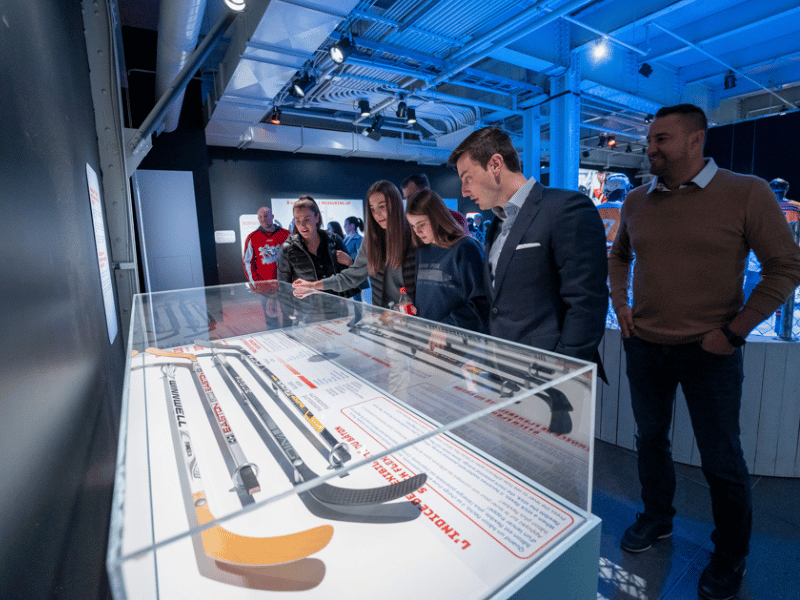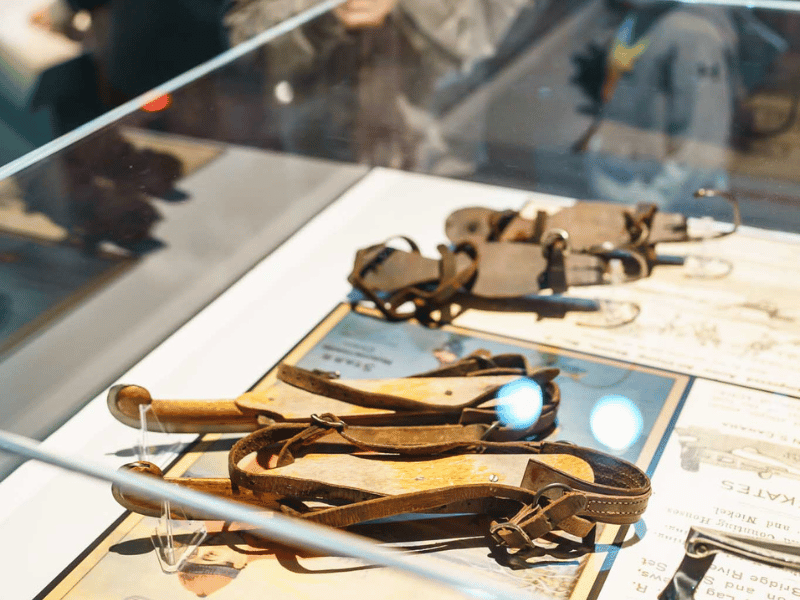The Extraordinary Evolution of Hockey Equipment
Today’s professional hockey is truly faster than ever. The game has come a really long way! At its origins, hockey is a mix of ideas taken from a number of different sports. Since then, advances in player training and player nutrition have allowed players to boost their performance, and the evolution of hockey equipment has helped too, all thanks to science and technology.
This is the last of three articles focused on hockey presented alongside our new feature exhibition Hockey: Faster Than Ever.
The Origins of Hockey: A Fascinating Blend of History
The game of hockey is a combination of ideas taken from different sports, including lacrosse, hurling, bandy, and rugby. Lacrosse was played by Indigenous people in Canada long before Europeans arrived. Lacrosse sticks have a net on one end which is used to catch, carry, and shoot the ball into the opponents’ goal. Even though there are no skates or body equipment in lacrosse, it’s easy to see its connection with hockey. Hurling has been played in Ireland for centuries and the stick it uses, called a hurley, looks a lot like a hockey stick. Bandy comes from The Netherlands and is played on the ice just like hockey, but with a ball rather than a puck. British rugby gave hockey its body checking and its rink zones. History is filled with lots of ball and stick games and many may have influenced the game of hockey as we know it today. The very first official ice hockey game in Canada is said to have been played in Montréal in 1875 by a group of McGill University students. Because of all these influences, ice hockey cannot be said to be a Canadian invention properly speaking, but its rules and the codes that govern it, now recognized worldwide, were definitely born in Canada much like many of the game’s developments.

The Hockey Puck: From Cow Dung to Synthetic Rubber
Would you believe that some of the very first hockey pucks were made from frozen cow dung? Sure, using animal droppings is one way to be environmentally minded, but it’s hardly a hygienic choice… and not a particularly durable one either! Early on, hockey players also used lacrosse balls to play but the shape of lacrosse balls, and the materials they were made from, made them tricky to handle on the ice. Indigenous-made lacrosse balls were usually made from wood or animal hair wrapped in deer skin. By the middle of the 19th century, hockey pucks were being made from square pieces of wood or rubber. These flat edges made them easier to handle on the ice. Later, the tops and bottoms of rubber balls were chopped off to make pucks giving them these same flat surfaces. At the beginning of the 20th century, multiple layers of rubber were glued together to make pucks, but these pucks would often fall apart and kept having to be replaced. Nowadays, hockey pucks are made with vulcanized synthetic rubber. The vulcanization process helps harden the rubber and make the pucks more resistant and durable.

The Hockey Stick: Once Hand Sculpted, Now Composite Materials
Around the 1900s, hockey sticks were made from a single piece of wood. Until industrial machinery came around, they were sculpted by hand, typically in Mi’kmaq communities in Nova Scotia.
Originally flat, the blades of the first hockey sticks helped keep the puck down on the ice, but the introduction of the curved blade in 1927 changed the game, so to speak, by giving players the ability to take powerful slap shots… which led to the invention of the goalie helmet! It was around 1930 that the goalie stick was changed to give it a wider base than the sticks used by other players. The game was getting faster and faster, so the equipment had to evolve to keep up!
Today’s hockey sticks aren’t made of wood anymore. They are made with sturdier, lightweight composite materials, like metal, fibreglass, Kevlar, or carbon fibre.

The Hockey Skate: Once a Simple Blade on the Sole of a Boot
In the first half of the 19th century, skates were simply a blade attached to a plank of wood tied with leather straps to the bottom of a boot or shoe. In 1850, American Edward W. Bushnell devised a steel blade that was much easier to work. A few years later, figure skater and former ballet dancer Jackson Haines screwed these blades directly into his boots. This helped him maintain his balance more easily on the ice and gave him better control when making jumps. And so the modern-day ice skate was born.
Today, hockey skates are much studier. This helps give hockey players more stability and also keeps their feet better protected. They are lightweight and customized to the players’ feet which lets players keep an even keel no matter how fast they skate. Skate blades are also rounded at either end which lets players make faster, sharper turns more easily. Skates today are made using an array of different materials, like composites (a mix of synthetic materials), plastic, and stainless steel.
Goalies need even more stability and protection than the other players on the ice, so their skates are slightly different. They have an additional layer of protection to protect their toes and heels from those fast-flying pucks, and the blade is longer, with a thicker, flatter edge. This means that more of the blade is in contact with the ice surface which offers additional stability. Goalie skate blades are also taller. This lets goalies spread their legs wider without the blades losing their grip on the ice, which helps a lot when using the goaltending technique known as “butterfly” style. Did you know that the goalie skate was invented in Montréal in 1909?
As you can see, technology and science have helped players perform better and faster on the ice over the years… and the game is better for it!
